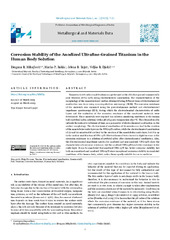| dc.creator | Mihajlović, Dragana | |
| dc.creator | Rakin, Marko | |
| dc.creator | Bajat, Jelena | |
| dc.creator | Đokić, Veljko | |
| dc.date.accessioned | 2023-12-14T12:39:07Z | |
| dc.date.available | 2023-12-14T12:39:07Z | |
| dc.date.issued | 2023 | |
| dc.identifier.issn | 2956-1787 | |
| dc.identifier.uri | http://TechnoRep.tmf.bg.ac.rs/handle/123456789/6975 | |
| dc.description.abstract | Nanostructured surface modification was performed on the ultrafine-grained commercially
pure titanium (UFG cpTi) using electrochemical anodization. The characterization of the
morphology of the nanostructured surface obtained during different times of electrochemical
anodization was done using scanning electron microscopy (SEM). The corrosion resistance
of the materials was examined using the potentiodynamic method and electrochemical
impedance spectroscopy (EIS), during which the electrochemical characteristics of oxide
layers and the evaluation of the corrosion resistance of the mentioned materials were
determined. These materials were exposed to a solution simulating conditions in the human
body (artificial saliva solution) with a pH of 5.5 at a temperature of 37 ºC. The obtained results
indicate the extensive influence of time, as a parameter of electrochemical anodization on the
surface morphology. The electrochemical anodization of 60 minutes can lead to the creation
of the nanotubular oxide layer on the UFG cpTi surface, while the electrochemical anodization
of 30 and 90 minutes did not lead to the creation of the nanotubular oxide layer, but it is up
to the surface modification of UFG cpTi. Electrochemical tests showed a slight increase in the
corrosion resistance in a solution of artificial saliva after electrochemical anodization. Also,
the electrochemical impedance spectra for anodized and non-anodized UFG cpTi show the
characteristics of corrosion resistance, but the anodized UFG cpTi has better resistance to the
oxide layer. It can be concluded that anodized UFG cpTi has better corrosion stability, but
both non-anodized and anodized UFG cpTi show exceptional corrosion stability in simulated
conditions of the human body, which makes them equally suitable for use in medicine. | sr |
| dc.language.iso | en | sr |
| dc.publisher | Association of Metallurgical Engineers of Serbia | sr |
| dc.relation | info:eu-repo/grantAgreement/MESTD/inst-2020/200135/RS// | sr |
| dc.relation | info:eu-repo/grantAgreement/MESTD/inst-2020/200287/RS// | sr |
| dc.rights | openAccess | sr |
| dc.rights.uri | https://creativecommons.org/licenses/by/4.0/ | |
| dc.source | Metallurgical and Materials Data. Advanced Functional Materials | sr |
| dc.subject | High-Pressure Torsion | sr |
| dc.subject | Electrochemical Anodization | sr |
| dc.subject | Commercially Pure Titanium | sr |
| dc.subject | Corrosion Resistance | sr |
| dc.subject | Human Body Solution | sr |
| dc.title | Corrosion Stability of the Anodized Ultrafine-Grained Titanium in the Human Body Solution | sr |
| dc.type | article | sr |
| dc.rights.license | BY | sr |
| dc.citation.epage | 11 | |
| dc.citation.issue | 1 | |
| dc.citation.spage | 7 | |
| dc.citation.volume | 1 | |
| dc.identifier.doi | 10.56801/MMD3 | |
| dc.identifier.fulltext | http://TechnoRep.tmf.bg.ac.rs/bitstream/id/17937/2_MMD_3.pdf | |
| dc.type.version | publishedVersion | sr |

